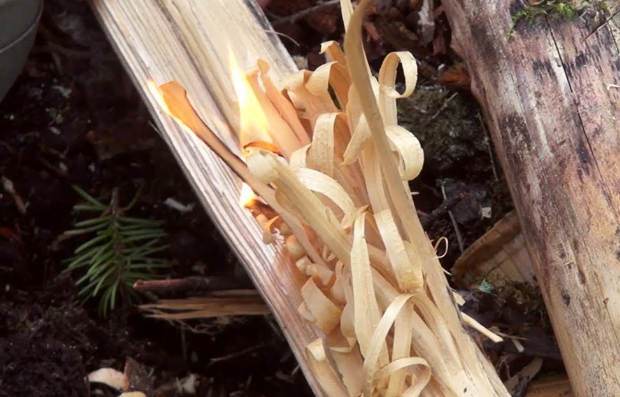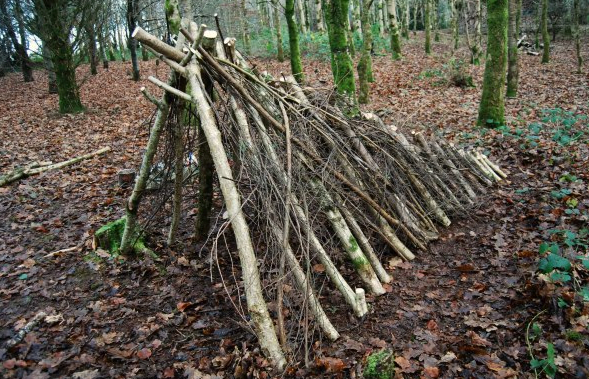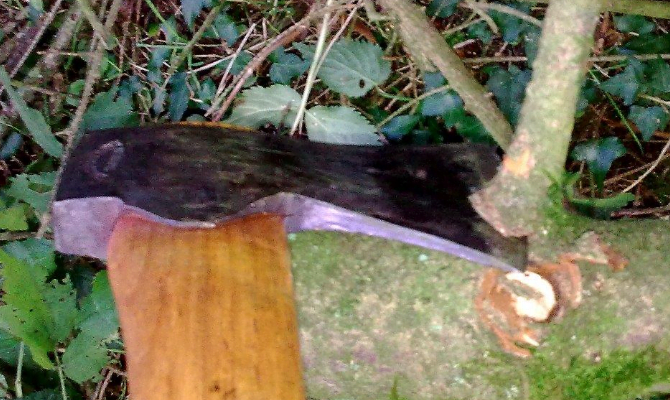Post Updated: 26 Feb 2023
A hatchet is one of those tools that has so many uses that it’s almost stupid not to include one in your itinerary for camping, backpacking, on the trail or deep in the wilderness.
You don’t want to be lugging around a full sized axe obviously, so this is where the mighty hatchet comes into it’s own.
This article covers 14 different jobs that a hatchet can do – I’m sure there’s more but 14 are all my feeble mind could come up with at the time!
TABLE OF CONTENTS:
Straight to the point – How to use a Hatchet
A hatchet is used as a one-handed wood chopping tool for various outdoor tasks, particularly with the aim of prepping kindling and firewood for a campsite.
14 Essential uses of a hatchet
1. Splitting kindling
For light jobs such as kindling for firewood prep, the hatchet is ideal. Working around the edges of a small log with your hatchet is by far the easiest method for harvesting kindling quickly.
The beauty of a hatchet as a cutting tool is having a razor-sharp cutting edge with the weight of the steel head to power through wood easily.
2. Creating tinder
To get a fire going you’ll need something smaller than kindling to start with. The sharp edge of a good quality hatchet should be sharp enough to shave the hairs off your arm – it’ll make short work of feathering some tinder from a nearby stick.
Simply shave down the length of the wood to produce some fine tinder to set a spark to.
3. Carving
Things like spears or stakes are a necessity in the wild and can be used for so many purposes. Even around camp, carving simple stakes can help with erecting tents, sturdy tripods for cooking, or carving feather sticks that can greatly increase your success in starting a fire in any weather.

A feather stick is any nearby stick that has been shaved with your hatchet to produce thin feathers of dry wood that increases the surface area of the wood to assist fire starting.
This is tricky at first but it’s an essential carving skill for the outdoors that gets easier with practice.
Once you get proficient at carving with your hatchet, why not advance to carving a spoon or bowl… or some extravagant masterpiece!
4. Driving tent stakes
A hatchet can easily double as a hammer if you flip it round and use the poll end. Ideal for hammering in tent stakes or any other job where a hammer is required. Just don’t use the poll against another steel surface because you’ll damage your hatchet.
5. Building a shelter

Constructing a simple lean-to shelter is easy with a good quality hatchet. You’ll need to limb some strong branches to build the frame which requires a sharp cutting edge with some chopping power. A saw would be just as useful here but not half as much fun!
6. Snow and ice tool
If you live someplace where there is snow and ice, a hatchet will come in really handy. Having a small chopping tool to break up blocks of ice is far easier than chipping away with a pick. Also handy for making a hole for ice fishing.
7. Chopping down small trees
Although felling large trees is best left to a bigger axe, a good quality hatchet will handle small diameter trees easily (up to 5 inches). Just chop into the tree on the diagonal as you move around in a circle removing pieces until its done.
8. Cleaning up limbs

Once a tree is felled the limbs are removed for a variety of purposes; building material, firewood etc. You wouldn’t use your felling axe for this purpose. A good sharp hatchet is ideal for limbing branches off felled trees in an efficient manner.
Limbing branches of rooted trees is also required on occasion. Maybe a tree in your garden needs a few branches removed to tidy it up or to create space. All you need is a quality hatchet for the job.
9. Processing game or fish
As vital a knife is in the hunting environment, you’re gonna need a cutting tool with a bit more power for splitting pelvis, ribcage, backbone, neck, etc. of your game.
There are so many tasks involved in processing game; a hatchet provides a razor-sharp cutting edge for slicing and skinning, while the chopping ability deals with the tougher tasks.
10. Throwing!
Have you heard about the current trend in axe throwing parties? It’s a big thing at the moment. A group of friends get together to throw hatchets at wooden targets while drinking beer! What’s not to like?
It’s also good to practice this in the field, just for fun. See if you can throw your hatchet and stick it in a nearby tree trunk – Safety first, obviously!
11. Self defence (In the wild)

For the survivalists among us. You never know when you’re safety could be threatened by unwanted visitors in the wild. Heaven forbid some wild animal takes a fancy to you – dispatch it (with love) by means of your trusty hatchet!.. Or, just run away!
12. Slicing (knife jobs)
Anything a knife can do, a good quality hatchet can do the same. Hatchets should be kept razor-sharp – sharp enough to shave the hair off your arm so should easily cope with any knife job you can think of.
The advantage of a hatchet is having the razor-sharp blade attached to a tool that is capable of slicing & skinning as well as chopping.
13. Campsite food prep
A hatchet’s versatility doesn’t stop at bushcraft. After a hard days toil in the wilderness building your shelter and hunting game or fishing in the river, simply clean up your hatchet and get to work preparing dinner. No need for kitchenware when your in the wild!
14. Digging
There may be times you need to dig holes for fires or just to loosen earth to assist with shelter building or trap making. With limited tools to hand your hatchet can be used to do this quite easily.
It has the weight and swinging power to make short work of digging a few holes – Just be sure to hone the edge again once you’re done so it’s always ready for action.
What’s the difference between an axe and a hatchet?
A hatchet is a small, one-handed axe that is primarily used for light work such as kindling firewood, making tinder, clearing brush and performing menial campsite duties.
A good quality hatchet can also be used for chopping down or limbing small trees and branches. The average size of a hatchet is around 14 inches in length and is a more transportable version of the axe.
An axe is for the big stuff – think felling big trees and splitting big logs in half.
Can a hatchet split wood?
Hatchets are great for splitting off small pieces of kindling, but this is best accomplished by chipping off the edges of a log. If you try splitting a big log down the middle with a hatchet, it’ll still be stuck there the next morning!
Splitting wood requires a specific tool designed for that purpose.
Related article: Wood Splitting – The best axes and accessories
Should a hatchet be sharp?
Axes and hatchets should be razor-sharp. They are for intricate work such as carving, limbing small branches, kindling firewood and performing duties around camp much the same as a bush knife.
Splitting axes and mauls – not so much. The big takeaway from this is: learn how to sharpen your axes properly – do it regularly, use the correct axe for the purpose it was designed to do, and you will have success!
Can you cut down a tree with a hatchet?
A good quality hatchet can chop down trees up to (roughly) 5 inches in diameter. A cheap hardware store hatchet will not be any use because they are made of cheap materials that wont stand up to any serious chopping action. The blade will dull quickly and the handle will probably snap.
A few high quality hatchets I would recommend for chopping small trees would be the following:
- Gransfors Bruks Wildlife Hatchet
- Hults Bruk Jonaker Hatchet
- Council Tool Velvicut Hudson Bay Hatchet
- 1844 Helko Werk Classic Pathfinder Hatchet
A couple of budget options I would recommend would be:
What is the best hatchet brand?
Gransfors Bruk are widely regarded as the best axe brand in the world. Their hand-forged axes are made by highly experienced master craftsmen with a key focus on producing the finest quality products.
The Gransfors Bruks Wildlife Hatchet is the king of hatchets, but expert axe producers such as Hults Bruk, Helko Werk both make quality hatchets. Some honorable mentions go to US brands Council Tool and Estwing.
Related Article: What is the best axe brand?
How do you sharpen a new hatchet?
A good quality hatchet can last a lifetime if properly cared for, and there’s no better way to ensure it stays with you to a ripe old age than by sharpening it yourself regularly to keep it in the optimum condition.
Besides the obvious dings and chips, a hatchets edge will dull slowly over time. This is imperceptible in the beginning but the more it dulls the more force you will need to exert in order to achieve the same result as a sharp hatchet.
Related Article: How to sharpen an axe – A step by step guide
What angle do you sharpen a hatchet?
The key to sharpening any axe or hatchet is to maintain the existing bevel. This is the point where the cheeks of the axe head join to form the cutting edge. Filing too shallow or too flat an angle will weaken the blade and reduce the blades effectiveness.
Always sharpen at an angle that complements the existing bevel of your axe or hatchet.
Conclusion
I hope this quick post has shown how versatile and essential a simple hatchet is for the outdoors. As I have said numerous times on this blog, if you invest in a good quality hatchet it will pay for itself in no time.
If your interested in an even more compact cutting tool, check out my article on The top 5 best mini hatchets!

Leave a Reply